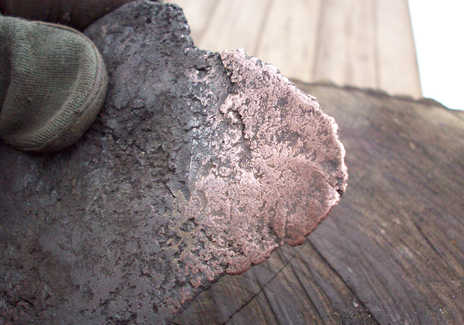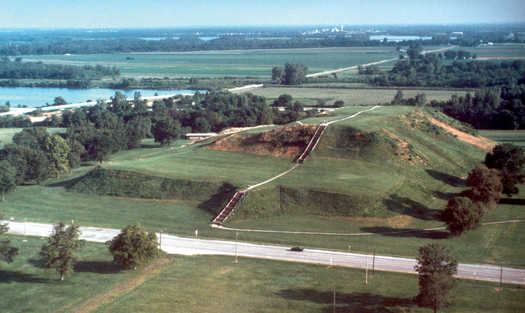
© BNDDetail of copper
Collinsville -- About 800 years ago, in a large room lit by a wood fire, fierce-looking men bedecked in bright feathers and polished copper ornaments gathered to smoke and talk.
Their intricate jewelry -- fanciful objects hammered from chunks of naturally occurring raw copper -- reflected the firelight. A variety of these ancient Mississippian-era copper decorations have turned up throughout Illinois and the Southeast United States, including triangular, 8-inch long-earrings embossed at the ends with a human face, headdress ornaments depicting stylized birds, even diminutive but carefully crafted copper ovals that may have been applied to a ritualistic leather belt or cape. When they are unearthed, these antiquities are covered with a green or gray patina.
Today, traffic on Collinsville Road passes a short distance from the collection of over more than 80 mounds where, archaeologists say, this American Stone Age scene is thought to have regularly occurred.
But there is something unique about a particular excavated area beside a rather plain looking mound -- Mound 34 -- that lies about 200 yards east of the world famous and huge Monk's Mound at Cahokia Mounds State Historic Site. The carefully sifted soil at this excavation has revealed evidence of the only known copper workshop from the Mississippian-era, a culture that peaked about 1250 A.D. throughout the middle and southern portions of America. The overall Illinois state site was the location of a large, prehistoric city of perhaps 20,000 that archaeologists call Cahokia.

© UnknownCahokia Mounds
"It's the only one (copper workshop) that's been discovered," said James A. Brown, professor of archaeology at Northwestern University in Chicago.
Brown and his research partner John Kelly, a lecturer in archaeology at Washington University in St. Louis, have for eight years led an investigation into finding the workshop and then carefully excavating the often minute particles and bits of copper that were left behind.
Brown said that the copper workshop was purely for religious purposes, to produce ornaments for those who participated in significant ceremonies that probably occurred atop the mounds.
"They are all depictions of other worldly beings," he said of the symbols and figures found in copper as well as on pieces of pottery and decorated shells.
The irony is that a self-taught archaeologist, Greg Perino, who grew up in Belleville and pioneered a sometimes heavy handed excavation style that featured bulldozing, actually discovered the copper workshop and another nearby nearly 60 years ago. Perino died in 2005 at age 91. However, his mapping was rudimentary and it took years to relocate his find.
"Perino left us something, even with the bulldozing," said Brown.
"You had to remember when he was working, in the '50s, there weren't the refined techniques we use today. He knew it was a copper workshop and he was very interested in it, but he regarded it as something that had been found elsewhere. What he didn't know or didn't realize or think about was there never has been one located elsewhere. Not that there couldn't be. It's just that no one has ever found one."
The rediscovery of the copper workshop has gained national attention. The National Geographic Society is helping to fund the research.
However, there isn't much left to see unless you're a trained researcher. Dark, circular stains in the soil of the 3-by-6-foot area where copper remnants have been found may be the remains of tree stumps that were used as anvils by ancient craftsmen. It's theorized that a flat stone was placed on a leveled off stump, and a palm-sized piece of very hard basalt, a volcanic rock, was used to pound raw copper flat.
A graduate student in metallurgy analyzed pieces of flat copper sheets found at Mound 34 and elsewhere using an electron microscope, and discovered from their molecular structure that they had been annealed, or repeatedly heated and cooled, like a blacksmith works iron.
Another graduate student, Lori Belknap, a mother of two from Mascoutah, is working on a master's degree in geology but has shown an intense interest in Mound 34. She cut a stump and got a flat rock and a chunk of rounded basalt. After first heating a piece of raw copper to about 600 degrees, she tried to pound the relatively soft metal to the thinness obtained by the Mississippians.
"I didn't have much luck," she said, but the copper did flatten out enough to show the technique was possible.
The overall purpose of most excavations at the mounds site, according to Kelly and Brown, is to determine the true role of Cahokia in the Southeast Ceremonial Complex, the string of ancient cities and mounds that stretched from Wisconsin through Illinois and on into Kentucky, Arkansas, Louisiana, Alabama and Georgia.
Brown said that the bits and pieces of the copper workshop have been studied in relation to peculiar fragments of an engraved drinking cup made from a conch shell found at the top of the about 10 foot high Mound 34. The shell, which probably came from the Gulf of Mexico, contains a very distinctive symbol, kind of an arrow-like logo with a circle in the arrowhead, that first turned up in excavations of rock shelters in Wisconsin and east central Missouri and dated from about 1000 A.D, more than two centuries before the peak of Cahokia.
Symbols found on the walls of the shelters are very similar to the shell fragments found atop Mound 34. The engraved arrows, like the Coca-Cola logo and other advertising of today, tied this ancient civilization to a symbol that all may have recognized.
Brown and Kelly theorize that religious leaders lived atop the mound, drank from the ceremonial cups and were supplied with decorative copper items to show their high rank from the workshop at the base of the mound.
And in turn, the workshop and the shell cup fragments hint that Cahokia may have been the center and not just an outlying fringe of the ancient Mississippian culture. The true role of Cahokia undoubtedly still lies buried. Unlike many other Mississippian sites that have been heavily excavated, less than 1 percent of the mounds site has been dug. While many artifacts have turned up, scientists working the site say what is left buried may greatly change current views of the civilization, and reinforce the theory that Cahokia may have been the center of it all.
"We've focused the last couple of years on the workshop," said Kelly, "But up above, on the top of the mound in remains of a building long since gone, we found those pieces of the engraved cups. ... In terms of the roots of the overall iconography (symbolism) of the area, it appears to be taking place at Cahokia."
Brown has theorized that the people of Cahokia may have gone as far as the Great Lakes to find raw copper and perhaps learned from people there how to work it.
"As we learn more will be able to see all of this in a very different, non-primitive storyline," Brown said, "We will see this as the run up to civilization."
Reader Comments
to our Newsletter